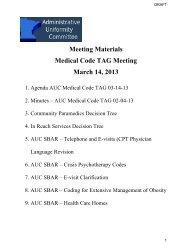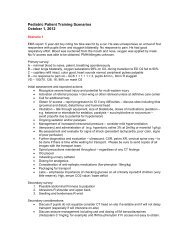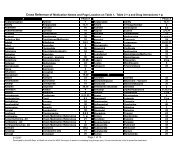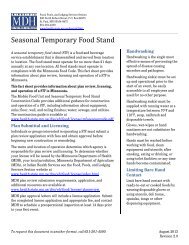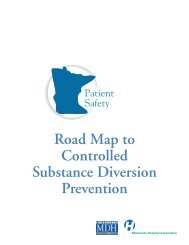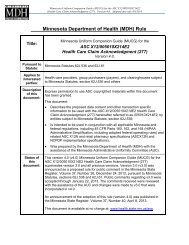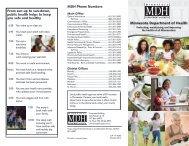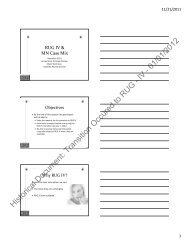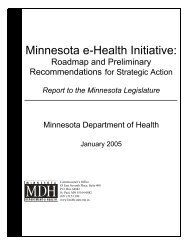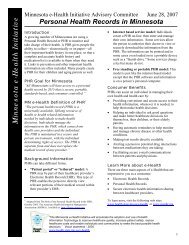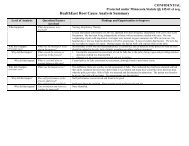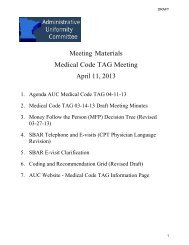Hearing Screening Training Manual - Minnesota Department of Health
Hearing Screening Training Manual - Minnesota Department of Health
Hearing Screening Training Manual - Minnesota Department of Health
You also want an ePaper? Increase the reach of your titles
YUMPU automatically turns print PDFs into web optimized ePapers that Google loves.
EXPLANATION OF RISK INDICATORS<br />
All <strong>of</strong> the risk indicators have been shown to have a potential impact on hearing in young children.<br />
A brief explanation <strong>of</strong> each indicator is provided below in order to ensure that accurate and<br />
pertinent information is obtained from each parent or caregiver.<br />
1. Caregiver concern regarding hearing, speech, language, or developmental delay.<br />
It is important that hearing loss be identified as early as possible to prevent speech, language and<br />
other developmental delays. Most parents are reliable reporters <strong>of</strong> their child’s development. The<br />
National Institute <strong>of</strong> <strong>Health</strong> Consensus Statement on Early Identification <strong>of</strong> <strong>Hearing</strong> Loss in<br />
Infants and Young Children (1993) stated that as many as 70% <strong>of</strong> deaf and hard <strong>of</strong> hearing<br />
children are identified because <strong>of</strong> parental concern.<br />
2. Family history <strong>of</strong> permanent childhood hearing loss.<br />
This question is aimed at identification <strong>of</strong> hereditary (genetic) hearing loss from both maternal<br />
and paternal family members, living or deceased, when known. However, a family history <strong>of</strong><br />
hearing loss is not necessary for the cause <strong>of</strong> a child’s hearing loss to be genetic. <strong>Hearing</strong> loss<br />
that is genetic is most <strong>of</strong>ten sensorineural. It is important to ensure that the relative’s hearing loss<br />
was not acquired (such as those resulting from meningitis, noise exposure, chemotherapy, or the<br />
aging process). Acquired hearing losses are not inherited. The type <strong>of</strong> loss which is inherited is<br />
typically present at a very young age. Semi-annual hearing screening is recommended because<br />
hereditary hearing loss may have delayed onset.<br />
3. Neonatal intensive care <strong>of</strong> more than 5 days or any <strong>of</strong> the following regardless <strong>of</strong> length <strong>of</strong><br />
stay: ECMO, assisted ventilation, exposure to ototoxic medication (gentimycin and<br />
tobramycin) or loop diuretics (furosemide/Lasix), and hyperbilirubinemia that requires<br />
exchange transfusion.<br />
Infants admitted to NICU are at greater risk for hearing loss. For example, infants with very low<br />
birth weight are at increased risk for both sensorineural and conductive hearing loss.<br />
Additionally, jaundice is a condition which occurs when there is too much by-product from the<br />
liver in the blood, eventually resulting in high bilirubin levels. Too much bilirubin<br />
(hyperbilirubinemia) is ototoxic and may cause hearing loss. Premature infants and infants with<br />
low birth weight are at greater risk for high bilirubin levels. Low bilirubin levels (slight jaundice)<br />
typically do not affect hearing. Also, infants who require prolonged use <strong>of</strong> mechanical<br />
ventilation are at risk for hearing loss (e.g., persistent pulmonary hypertension, conditions<br />
requiring the use <strong>of</strong> extracorporeal membrane oxygenation (ECMO)).<br />
4. In utero infections, such as CMV, herpes, rubella, syphilis, and toxoplamosis.<br />
The presence <strong>of</strong> these infectious agents has been linked to hearing loss in children. The majority<br />
<strong>of</strong> infections in pregnant women involve the upper respiratory and gastrointestinal tract and are<br />
not known to cause hearing loss. However, some infectious agents, contracted by the mother<br />
during pregnancy, may cross the placental barrier and invade fetal tissue. Severe infections,<br />
especially those occurring in the first trimester, can be related to hearing loss since this is when<br />
11




